Night shuttles in London prioritize passenger safety and reliability through rigorous protocols, including regular vehicle inspections and comprehensive driver training. Available from 10 PM to 4 AM, these services cater to those needing transportation during late hours, ensuring a secure travel option. Drivers are trained in emergency response and customer service, equipping them to navigate the challenges of nighttime travel effectively.
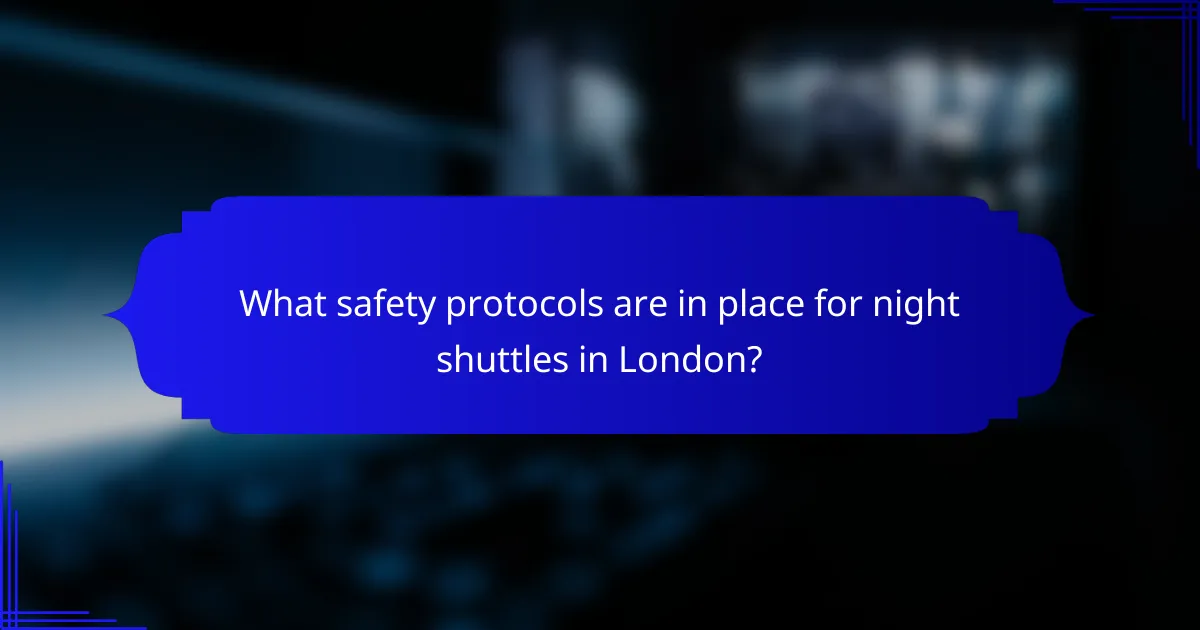
What safety protocols are in place for night shuttles in London?
Night shuttles in London implement several safety protocols to ensure passenger security and vehicle reliability. These measures include regular vehicle inspections, driver training in emergency response, passenger identification verification, GPS tracking, and robust communication systems for emergencies.
Regular vehicle inspections
Regular vehicle inspections are crucial for maintaining the safety of night shuttles. Vehicles undergo thorough checks to ensure they meet safety standards, including brakes, lights, and tires. Inspections typically occur weekly or bi-weekly, depending on usage and mileage.
Drivers are trained to conduct pre-trip inspections, allowing them to identify any potential issues before starting their shifts. This proactive approach minimizes the risk of breakdowns and accidents during service.
Emergency response training for drivers
All drivers receive emergency response training to handle various situations effectively. This training covers first aid, conflict resolution, and procedures for dealing with emergencies such as accidents or medical incidents. Drivers are equipped to remain calm and provide assistance when needed.
Regular refresher courses ensure that drivers stay updated on best practices and any new protocols. This ongoing education enhances their ability to respond swiftly and appropriately in critical situations.
Passenger identification verification
Passenger identification verification is a key safety measure for night shuttles. Drivers may require passengers to show identification, particularly during late-night hours, to ensure that only authorized individuals are using the service. This helps prevent unauthorized access and enhances overall security.
Some services may implement a digital verification system, allowing passengers to confirm their identity through a mobile app or ticketing platform. This approach streamlines the process while maintaining safety standards.
GPS tracking for all vehicles
GPS tracking is employed for all night shuttle vehicles, providing real-time location data to the dispatch center. This system allows for efficient route management and enhances passenger safety by enabling quick response to any incidents.
In case of emergencies, the GPS system can assist authorities in locating the vehicle promptly. Passengers can also track their shuttle’s arrival time, improving their overall experience and reducing wait times.
Communication systems for emergencies
Effective communication systems are essential for handling emergencies during night shuttle operations. Drivers are equipped with two-way radios to maintain contact with the dispatch center, ensuring immediate assistance can be provided if needed.
Emergency protocols include clear communication channels for reporting incidents, allowing for swift action. Passengers are often informed about how to reach out for help during their journey, enhancing their sense of security while using the service.
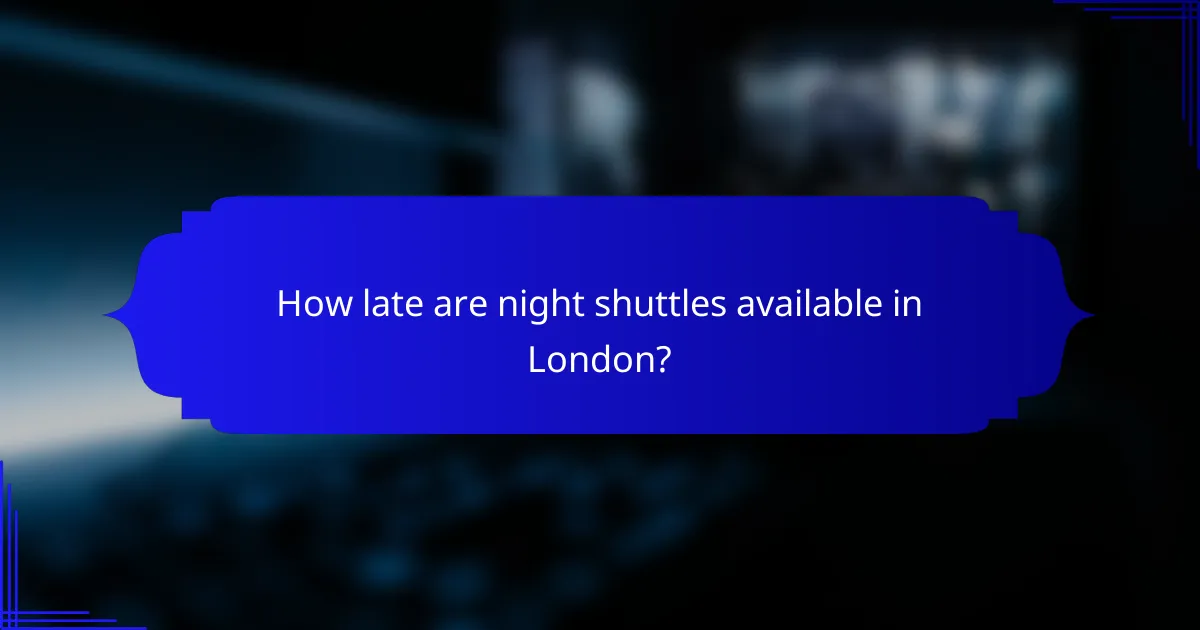
How late are night shuttles available in London?
Night shuttles in London are typically available from 10 PM to 4 AM, providing essential transportation during late hours. This service is designed to accommodate those needing to travel after regular public transport hours.
Service hours from 10 PM to 4 AM
The night shuttle service operates between 10 PM and 4 AM, ensuring that passengers have access to transportation during the late-night hours. This schedule is particularly beneficial for those returning from events, late shifts, or social gatherings.
Passengers should be aware that shuttles may run less frequently during the early morning hours, so planning ahead is advisable. Checking the specific route schedules can help avoid long waits.
Frequency of shuttles every 30 minutes
Shuttles run approximately every 30 minutes during operational hours, providing a reliable option for late-night travel. This frequency allows passengers to plan their journeys with a reasonable expectation of wait times.
It’s important to note that during peak times, such as weekends, shuttles may experience higher demand, potentially affecting wait times. Travelers should consider this when planning their trips.
Extended hours on weekends and holidays
On weekends and public holidays, night shuttles may operate with extended hours, often starting earlier or ending later than the standard schedule. This adjustment caters to increased demand during these times.
Passengers are encouraged to check the specific service announcements for any changes to the usual timetable, as holiday schedules can vary significantly. Being informed can enhance the travel experience and ensure timely arrivals at destinations.
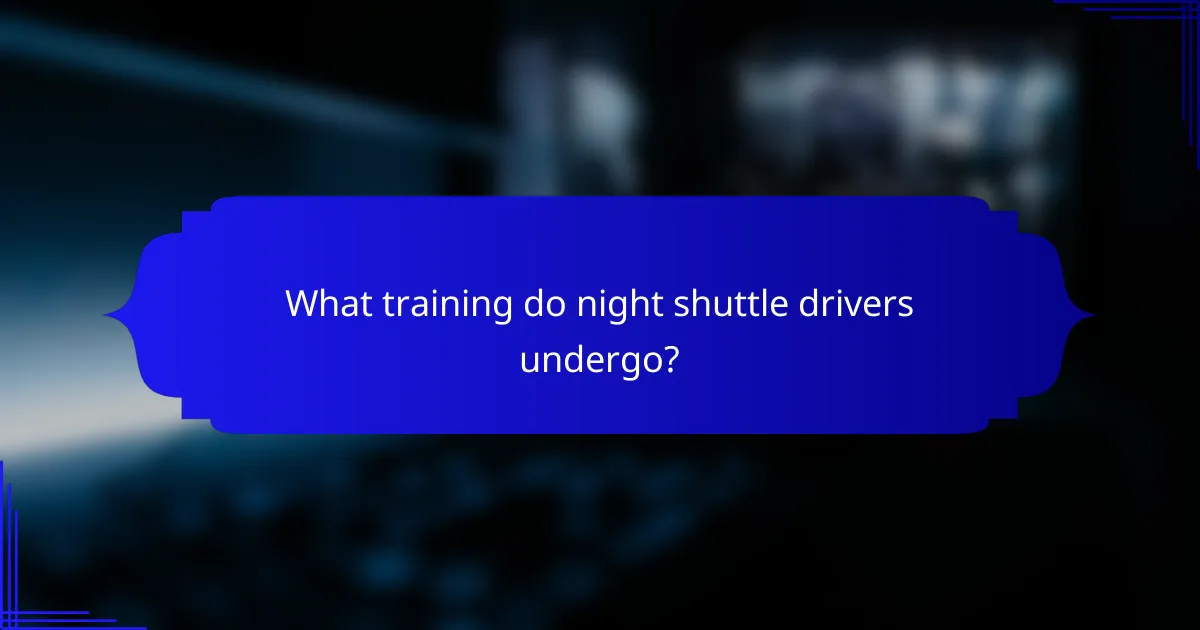
What training do night shuttle drivers undergo?
Night shuttle drivers undergo comprehensive training that focuses on safety, customer service, and emergency response. This training ensures that drivers are well-prepared to handle the unique challenges of late-night transportation.
Defensive driving techniques
Defensive driving techniques are crucial for night shuttle drivers to navigate safely during low visibility and potentially hazardous conditions. Drivers are trained to anticipate the actions of other road users and maintain a safe distance from vehicles and pedestrians.
Key components of defensive driving include scanning the road ahead, adjusting speed according to conditions, and using mirrors effectively. This proactive approach helps reduce the risk of accidents and enhances overall safety for passengers.
Customer service and conflict resolution
Customer service training equips night shuttle drivers with the skills to interact positively with passengers, ensuring a pleasant experience. This includes effective communication, patience, and the ability to address passenger needs promptly.
In addition, drivers learn conflict resolution strategies to handle difficult situations, such as disputes over fares or passenger behavior. Techniques include active listening, remaining calm, and seeking to find a compromise that satisfies both parties.
First aid and emergency procedures
First aid training is essential for night shuttle drivers, enabling them to respond effectively to medical emergencies. Drivers learn basic first aid skills, including CPR and how to use an automated external defibrillator (AED), which can be critical in life-threatening situations.
Emergency procedure training covers actions to take in various scenarios, such as vehicle breakdowns or accidents. Drivers are instructed on how to secure the scene, contact emergency services, and assist passengers until help arrives, ensuring safety and support during crises.
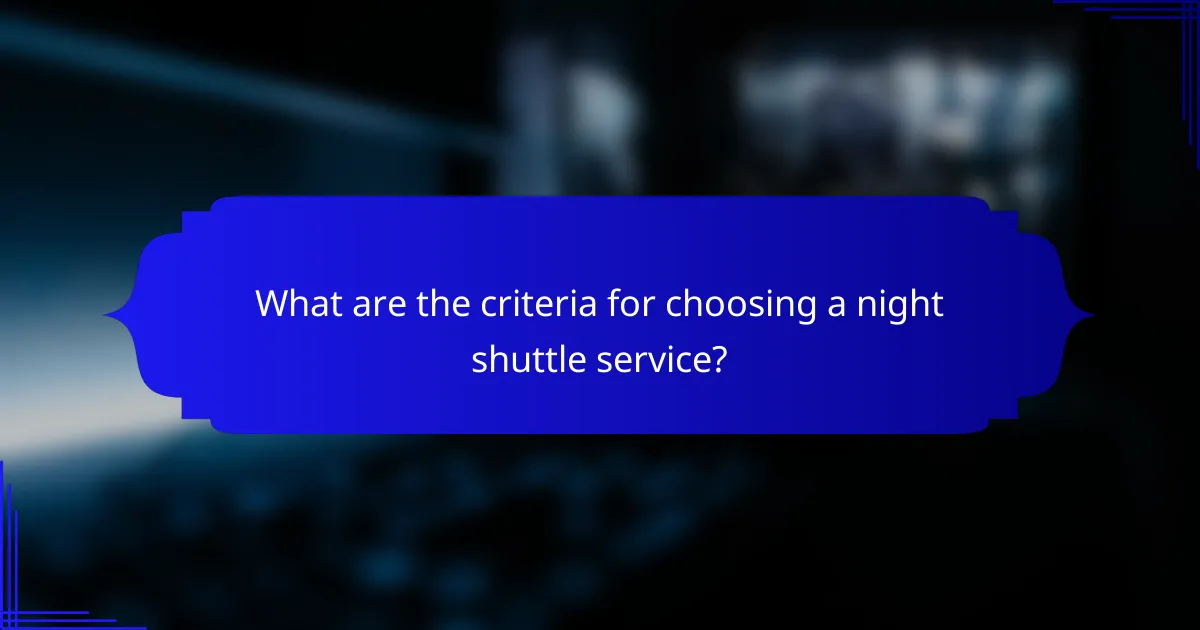
What are the criteria for choosing a night shuttle service?
When selecting a night shuttle service, prioritize safety, driver qualifications, and real-time tracking features. These criteria ensure a reliable and secure travel experience during late-night hours.
Safety ratings and reviews
Safety ratings and customer reviews are crucial indicators of a night shuttle service’s reliability. Look for services with high ratings on platforms like Google or Yelp, where users share their experiences regarding safety and punctuality.
Consider checking if the service has undergone safety audits or holds certifications from relevant transportation authorities. A consistent track record of positive reviews can provide peace of mind when traveling at night.
Driver qualifications and experience
Qualified drivers are essential for a safe night shuttle experience. Ensure that the service employs drivers with valid licenses, clean driving records, and adequate training in safety protocols.
Experience matters; drivers with several years in the industry are often better equipped to handle late-night challenges. Some services may also require drivers to complete background checks and undergo regular training sessions.
Availability of real-time tracking
Real-time tracking enhances safety and convenience for night shuttle passengers. This feature allows riders to monitor their shuttle’s location and estimated arrival time via a mobile app or website.
When choosing a service, confirm that it offers a reliable tracking system. This can help reduce anxiety about waiting times and ensure that you can share your ride details with friends or family for added security.
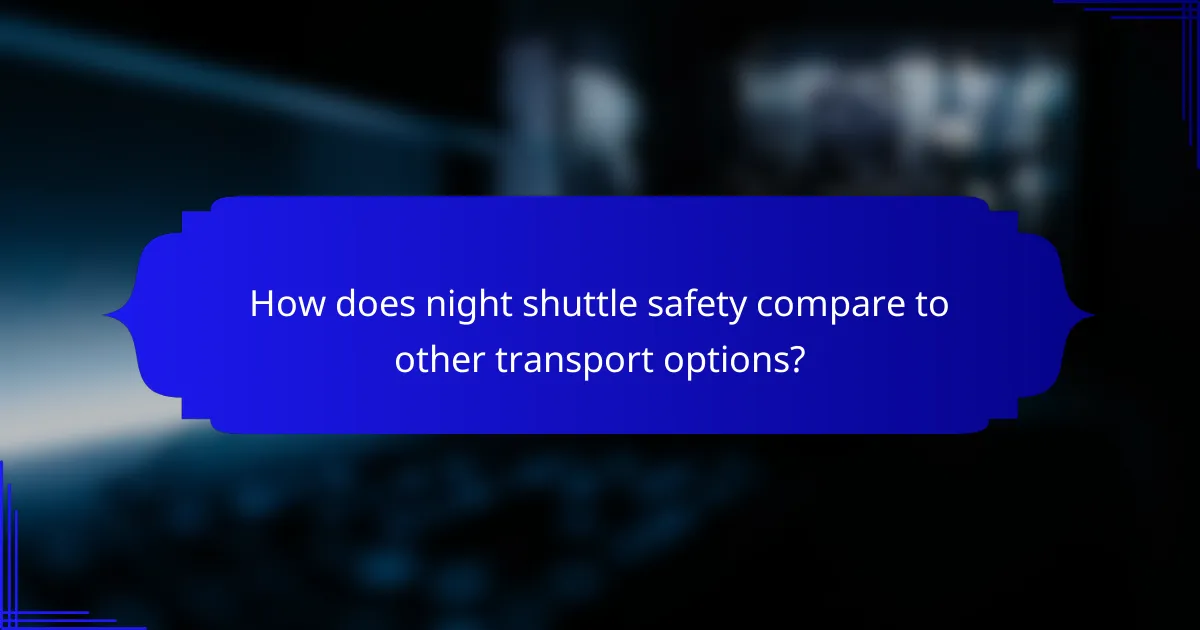
How does night shuttle safety compare to other transport options?
Night shuttles generally offer a high level of safety, often comparable to or exceeding that of other transport options like taxis and public transport. Key factors include driver training, vehicle maintenance, and adherence to safety protocols.
Comparison with taxi services
Night shuttles often have stricter safety protocols than traditional taxi services. For instance, shuttle drivers typically undergo more comprehensive training, including defensive driving and emergency response techniques.
Additionally, night shuttles may implement GPS tracking and real-time monitoring, enhancing passenger safety. In contrast, taxis may not always have such systems in place, leading to varying levels of safety depending on the service provider.
Comparison with public transport
Public transport systems, while generally safe, can be less reliable during late-night hours due to reduced service frequency and limited routes. Night shuttles, on the other hand, are specifically designed to cater to late-night travelers, providing more direct and timely service.
Moreover, night shuttles often prioritize passenger safety through features like well-lit pick-up and drop-off locations, which may not always be available with public transport. This focus on safety can make night shuttles a preferable option for those traveling late at night.
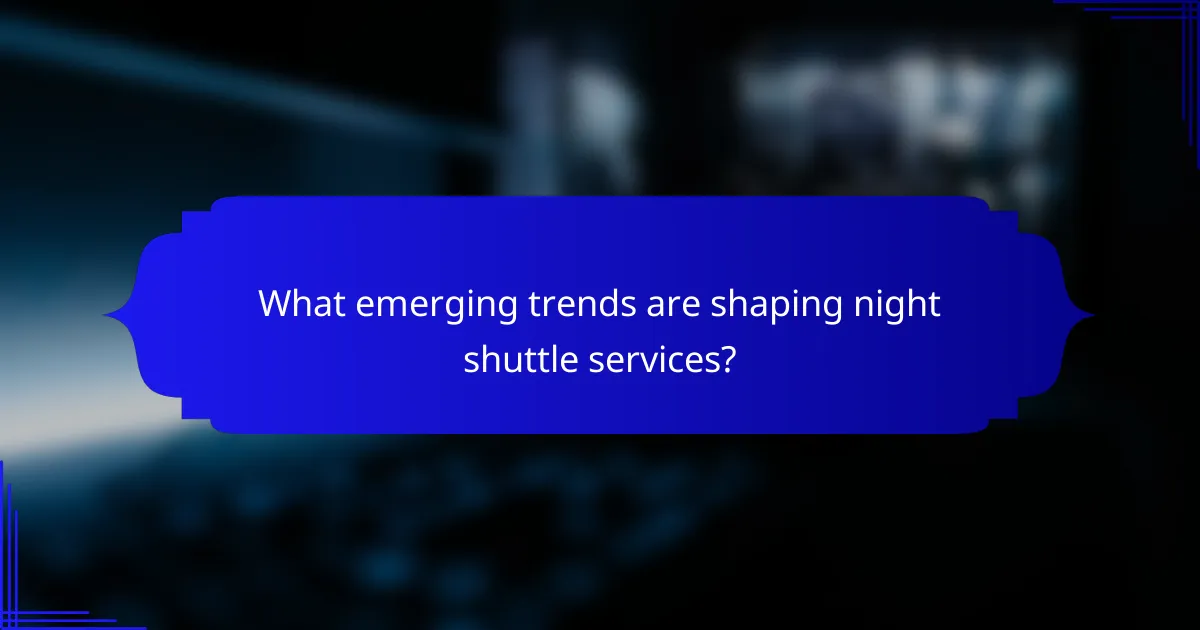
What emerging trends are shaping night shuttle services?
Emerging trends in night shuttle services focus on enhancing safety, efficiency, and sustainability. Key developments include the integration of electric vehicles and the use of artificial intelligence for route optimization, both of which aim to improve the overall passenger experience during late-night travel.
Integration of electric vehicles
The integration of electric vehicles (EVs) into night shuttle services is becoming increasingly common. EVs offer lower operating costs and reduced emissions, making them an environmentally friendly choice for late-night transportation. Many shuttle services are transitioning their fleets to electric models, which can also provide quieter rides.
When considering the switch to electric vehicles, operators should evaluate the availability of charging infrastructure and the range of different models. For instance, some EVs can travel over 300 kilometers on a single charge, making them suitable for most urban night shuttle routes.
Use of AI for route optimization
Artificial intelligence is transforming how night shuttle services plan their routes. By analyzing real-time traffic data, passenger demand, and historical patterns, AI can optimize routes to reduce wait times and improve service reliability. This technology helps ensure that shuttles are where they are needed most during late-night hours.
Shuttle operators should invest in AI systems that can adapt to changing conditions, such as traffic congestion or special events. Implementing these systems can lead to significant improvements in efficiency, potentially reducing travel times by a notable percentage and enhancing customer satisfaction.
